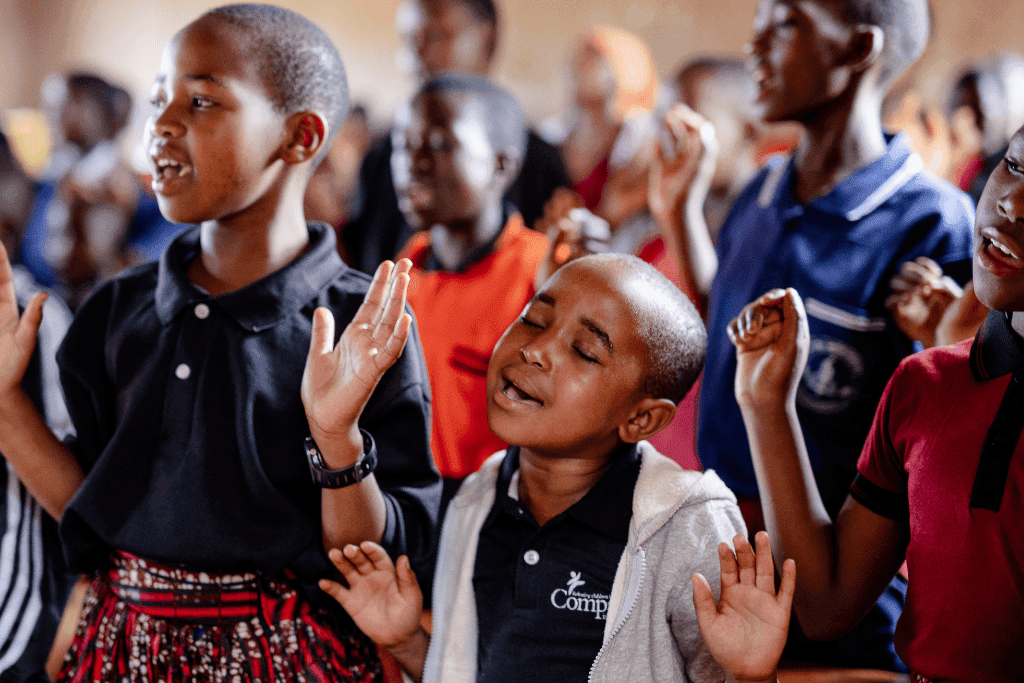Discover more
The Lord’s Prayer
Find comfort, inspiration and encouragement by learning about The Lord’s Prayer.

The Lord’s Prayer is known the world over and is treasured by Christians young and old. It’s recited in school assemblies, at family mealtimes, and in church services. You’ll hear it spoken out loud by groups, muttered quietly by individuals… and even sung. It’s a prayer to say when facing a time of trial, or during a season of plenty. It brings hope to millions of people in every language and context imaginable.
But what is The Lord’s Prayer? Where is it found in the Bible? What are the different versions of it, who wrote it, and what, importantly, does it all mean?
Here, we’ll guide you through all your questions about The Lord’s Prayer. We hope you’ll find encouragement and inspiration in its beautiful, ancient and endlessly relevant words.
We’ve created a downloadable resource to help you reflect on each line of The Lord’s Prayer. Why not use the discussion questions with your family or church small group?
Where does The Lord’s Prayer come from?
The Bible tells us that The Lord’s Prayer was first spoken by Jesus himself. His followers had asked him how to pray, and he answered them by teaching them the words that became known as The Lord’s Prayer. It’s a short, simple prayer that two thousand years later is still being used in acts of worship by Christians every day. It’s also often one of the first prayers children learn. If you're thinking about how to pray more intentionally for the young ones in your life, these prayers for children can help you lift up them up to our loving Heavenly Father.
The Lord's Prayer plays a central role in Anglican worship, featuring throughout the Book of Common Prayer, and is known as the ‘Our Father’ prayer in the Catholic church. But, given that its words come to us straight from Jesus Christ, the Son of God, it’s a prayer that can transcend all differences and denominations.
What Bible verse is The Lord’s Prayer found in?
The Lord’s prayer can be found in two places in the New Testament: in Luke 11:2-4 (which is a slightly shorter version) and as part of Jesus’ Sermon on the Mount in Matthew 6:9-13 following the beatitudes. There may have been lots of occasions where Jesus taught the prayer to his followers and people he encountered while he was preaching about the Kingdom of God, but these are the two that were recorded by the writers of the Gospels.
What are the different versions of The Lord’s Prayer?
These days, you’ll usually find two different versions of The Lord’s Prayer being said at church services and in private prayer: the modern version, and the traditional version. Both are based on the words found in Matthew 6:9-13. We’ve included the prayer as it most commonly appears in liturgy below:
Modern version
Our Father in heaven,
hallowed be your name,
your kingdom come,
your will be done,
on earth as in heaven.
Give us today our daily bread.
Forgive us our sins
as we forgive those who sin against us.
Lead us not into temptation
but deliver us from evil.
For the kingdom, the power,
and the glory are yours
now and for ever.
Amen.
Traditional version
Our Father, who art in heaven,
hallowed be thy name;
thy kingdom come;
thy will be done;
on earth as it is in heaven.
Give us this day our daily bread.
And forgive us our trespasses,
as we forgive those who trespass against us.
And lead us not into temptation;
but deliver us from evil.
For thine is the kingdom,
the power and the glory,
for ever and ever.
Amen.
Whether you use the modern or traditional translation is entirely up to you! Neither one is ‘better’ than the other – it’s simply a matter of personal preference.
How can I pray The Lord’s Prayer?
However you like! Whether you pray it through as part of your morning prayer or evening devotions, what matters most is that the words come from your heart. Whether you say them kneeling on the floor with your hands folded and eyes closed, or just while walking down the street, God will hear you.
Watch this video to hear The Lord’s Prayer being recited by Compassion participant, Samuel.
The faith of children like Samuel is inspiring. At Compassion, our Christ -centred, child-focused, church-driven approach brings the hope of Jesus both practically and spiritually. We would love it if you would join this movement of Compassion and transform a life by sponsoring a child today.
The meaning of The Lord’s Prayer: a line-by-line guide
“Our Father in heaven…”

The Lord’s Prayer begins by both acknowledging who we’re praying to and also saying something about what they are like: “our Father who art in heaven”. God is described as a ‘Father’ – a relationship of closeness and deep love. Yet he is also described as ‘in heaven’: this doesn’t necessarily mean a physical place; but is rather talking about the vastness, the mystery and the holiness (specialness) of God.
So, in The Lord’s Prayer, Jesus teaches us that we have a God of both intimacy, and of majesty. Amazing!
“Hallowed be your name…”
‘Hallowed’ is an old fashioned word meaning something that is holy. It implies something that is special, set apart, and of incredible importance.
When we say that God's name is hallowed, we’re declaring its significance – that is worthy of great respect and honour, and not something to be taken lightly. How incredible then that this extraordinary, hallowed God loves each of us unconditionally.
“Your Kingdom come…”
“The Kingdom of God” again doesn’t simply mean a physical place. It refers to a way of doing things, a way of being. The Kingdom of God is what the world looks like when everything is in harmony – when every person and every living thing can flourish. It is what the world looks like when it is freed from fear, freed from hate, freed from poverty.
When we say “Your Kingdom come”, we are saying that this is what we want the world to be like, and that we are willing to help bring it about through evangelism and sharing Jesus’ love.
“Your will be done…”

What is God’s will? The Bible tells us that God is love, and that God’s desire for us is to live in love (1 John 4:7-12). Similarly, Jesus said that the greatest commandment – the most important thing we can do – is to love.
When we say “Your will be done”, we are asking for there to be more love in the world. For this to happen, we might sometimes need to put aside our own desires. To heal the world, we can start by thinking less about what we want, and more about what’s best for all – God’s will.
“On Earth as it is in Heaven…”
“On Earth” is the way things are. “In Heaven” is the way things ought to be; the way things could be. “On Earth” is things that might be broken, or wounded. “In Heaven” is a realm where everything is made whole.
To ask for things to be “On Earth as it is in Heaven” is to ask for repair, for healing, and for justice. This line tells us that things don’t have to be the way they are: that change is possible.
“Give us this day our daily bread”

We all have our daily needs – the things we require both to survive and to thrive. This line asks God to provide us with these things. Yet it also subtly reminds us not to ask for more than we need. When we ask for our daily bread, we’re leaning into God’s promises - trusting in his provision for every season.
What do we need to get through this day? What do we need to live lives of love? Are some of the things we desire actually getting in the way of that? “Our daily bread” grounds us in God’s provision, rather than in a desire for more. And in a world of such great inequality, it is a reminder that the bread we have can also be shared.
“Forgive us our sins…”
“Sin” can be an off-putting word for many people, bringing with it connotations of shame and judgement. But “forgive us our debts” means something that we know already: that all of us sometimes fall short. We make mistakes. We do things that we wish we didn’t; we don’t do things that we wish did. We hurt people.
Yet God’s grace is infinite. There is always, always forgiveness. Which means we can always start again; we always have the opportunity for a second chance. We are loved more than anything we could ever do wrong. God's love is greater than any mistake that we could make. These Bible verses about love reflect the kind of grace that welcomes us back, again and again.
“As we forgive those who sin against us…”
As we live in God’s grace, so we are called to extend that grace to others. This line reminds us that we are all human beings, all with our own struggles and shortcomings. God has compassion upon us, and so we should have compassion too. Just as in the parable of The Good Samaritan, Jesus invites us to extend grace even when it’s inconvenient or costly.
Forgiveness does not mean that it’s okay that we were hurt; it means that we’re choosing to not let it hurt us anymore. And so, the work of repair can begin.
“Lead us not into temptation…”

A clearer way to phrase this might be, “Help us to not give in to temptation.”
We all know what temptation feels like, and how it can lead us away from what we know is right. God sent his Holy Spirit to us to help guide us through those situations. With God, we can find both the wisdom to know the right path and the strength and courage to follow it. Resisting temptation and walking with God is made possible when we cultivate the Fruit of the Spirit, living spirit-empowered lives marked by love, joy, peace and self-control.
“But deliver us from evil…”
Evil does exist in the world. But there is also good, and that through that good, evil can be overcome (Romans 12:21). God can deliver us from the evil one. The Bible tells us that there is a light in the world that no darkness can extinguish (John 1:5). This light – the light of Christ – can live within us, and we are called to share that light with others, helping to create a better world.
At times, the darkness can feel overwhelming and overpowering but God's Word can be a powerful source of light. These encouraging Bible verses offer hope and strength to help you keep walking in faith, trusting that God is able to deliver.
“For the kingdom, the power, and the glory are yours…”
This line is all about declaring God’s sovereignty. It says to God, “You’re the one in charge.” It tells us that life isn’t all about us. This is a humbling thought, yet also a freeing one. We do not have to carry the weight of the world on our shoulders; this is God’s story, not ours – yet we are each invited to play our part.
You may have noticed that this line isn’t always included in the Bible’s record of The Lord’s Prayer. That’s because it was added to the prayer at a later date by the Church. Whether or not you say it is completely up to you, but there’s no denying it’s a powerful statement.
“Now and for ever. Amen.”
God is the same yesterday, today and forever (Hebrews 13:8). God isn’t going to change; he isn’t going to leave us; his love will never fail us. So many things in this life are temporary, but God is the rock that we can cling to in confidence no matter what.
When we say “Amen”, we are declaring that we agree with the prayer and want to see it come to pass. Which we definitely do!
As Compassion graduate, Richmon Wandera, says, ‘Prayer is powerful. It is the invisible bond that ties us to God, aligning our steps with his extraordinary plans and purposes. My life is living proof of how prayer can ripple out to bless countless lives, far beyond anything we could ever imagine.’ You can read Richmond’s story here.
Frequently Asked Questions about The Lord’s Prayer
Which is the best version of The Lord’s Prayer?
Whichever one you decide to pray next! God isn’t fussy about the exact wording, and you shouldn’t be either. The versions we’ve listed above are commonly accepted as being true to the original texts. Some versions might have ‘debtors’ instead of ‘sins’ or ‘trespasses’, but ultimately it’s trying to convey the same meaning.
When was The Lord’s Prayer written?
The Lord’s Prayer is written in the gospels of Matthew and Luke, both of which are estimated to have been written between the years AD 75 – 90. The prayer was spoken by Jesus during his time of ministry, which was some time between AD 27 – 36. In other words, about 2,000 years ago.
The final lines of The Lord’s Prayer (known as the ‘doxology’) – “For the Kingdom, the power and the glory are yours, now and forever” – was added by the early Church some time in the first century AD, not long after the gospels became widely circulated.
What’s the difference between the ‘Our Father’ prayer and The Lord’s Prayer?
Both the Our Father prayer and The Lord’s Prayer refer to the same thing. They’re just different terms used for the same prayer. ‘Our Father’ is generally used as the title in Catholicism, whereas The Lord’s Prayer is generally used as the title in Protestant denominations. The ‘Our Father’ prayer usually omits the doxology – the final lines of the prayer that begin, ‘For the kingdom, the power and the glory…’
Who wrote The Lord’s Prayer?
The words of The Lord’s Prayer were spoken by Jesus. We don’t know exactly who was the first person to write it down, but the first surviving records we have of it are in the biblical gospels of Matthew and Luke. These books were named after the people said to have written them: Matthew, one of the twelve apostles (closest followers) of Jesus; and Luke, a physician who was alive at the time of Jesus.
Which version of The Lord’s Prayer is used in the Book of Common Prayer in the Church of England?
The Book of Common Prayer uses the traditional version of The Lord’s Prayer. It is based upon the translation from the 1611 King James Bible.
Words by
Gideon Heugh
Share:
Share: